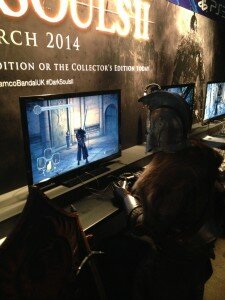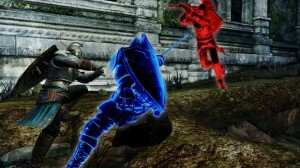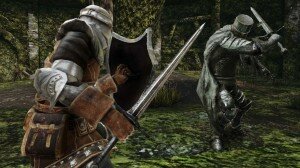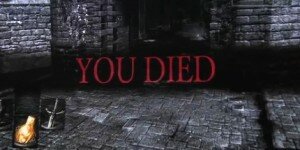This scene from the IT Crowd pretty much sums up how a lot of gamers talk about From Software’s Dark Souls.
It’s true to a certain extent. You do die a lot. The only problem is that Death in the gaming world has developed a stigma. For some gamers if you die it must be game’s fault, it’s broken, It’s cheap or just plain shit.

A typical Dark Souls player
So mollycoddled have we become and brainwashed by American attitudes towards game design and storytelling that every last game must put you in the role of the kick ass invincible hero. You can’t die; you are the number one guy, the main man, this particular fictional universe’s special ray of sunshine.
So what scares the shit out of a lot of gamers about the Souls series is that it eschews all of these things that modern gamers have come to expect. You are not a unique and delicate snowflake in the world of Demon/Dark Souls, you are Joe’s broken and beaten body. The game breaks you down and reforms you in a manner it sees fit. You can tell the people that have braved Darks Souls from those that haven’t. They exchange the same knowing looks that the members of a fight club do.
With Dark Souls II it’s clear that From Software is on a serious recruitment drive. This is stage two of Project Mayhem, extending the reach of Dark Souls from a niche game to a main stream success.
Soon we’ll all be staring at each other with the same steely gaze: you were there, you know how tough it was, but you came, you saw, you kicked its ass and left a note.

Mythra The Bane of My Existance.
That’s how Dark Souls II makes you feel, whilst many games make you feel like the hero for a couple of hours, the sense of satisfaction you’ll feel after overcoming Drangleic’s resident nightmare fuel is almost over whelming. There are plenty of nasty bastards to keep you up at night too; hulking armoured warlords, ancient Giants that look like they’re carved from the earth and that god damned venomous snake-witch-thing and many others besides.
Each Boss fight is like a game of poker, find the tell and you’ll win. Stack the deck and your chances are increased even further.
You’re also never quite alone in your misery, unless you want to be. You can of course play the entire game offline if you want to, but I wouldn’t recommend it. The best part of the whole Souls experience has always been the fact that even in the darkest dungeon you’re never quite alone. From Software’s greatest achievement is to create a series in one of the most antisocial genres with social features at its core.
Once again you’ll be surrounded by the ghosts of other players reliving their final moments, warnings and tips scrawled in to the brick and stone and mud to help weary travellers. However, Dark Souls II also introduces new and interesting ways to help or screw over your fellow dungeon divers via the game’s revamped, and greatly improved Convenant system.

Never fear! The Blue Sentinel is here!
At some point, you’ll encounter some homicidal douche bag from the Brotherhood of Blood (DS II’s version of the Darkwraiths) with a handle like ‘Iwishmadikwozazbigazdizsw0rD69’ lumbering towards you from the darkness ready to shove a scimitar where the sun don’t shine. What’s more, these guys can now turn up at any point in the game. Knowing that someone else has invaded your realm immediately fills you with an all too familiar sense of dread. However this time From Software have given players the means to better defend themselves against these would be assassins. Providing players with an item to even the score a little that turns local monsters against the gits. You can also join The Way of the Blue covenant to gain protection from the Blue Sentinels; other players that are part of a covenant that specifically hunts down invaders into other player’s games.
It’s a nice twist and a very Dark Souls way of introducing a more balanced PVP system. You can be a jerk, but be warned, the game won’t like you for it.
The most interesting Covenants though are the Bell Ringers and the Rat King Covenant who guard different areas of the map and are summoned to defend them should someone else be foolish enough to venture into their domains. The Bell Ringers will assemble at the top of the bell tower to assault any that attempt to assail the keep. Whilst those who pledge their fealty to The Rat King protect the Grave of Saints: an area infested with rats and hollows, not only will these not attack you once you’ve joined the covenant but you will also be able to lay traps throughout the tomb to help protect it from would-be grave robbers.

Hint: Leave the sleepijng knight alone!
Drangleic itself is absolutely huge, dwarfing the previous setting of Lordran with a variety of locales that is absolutely staggering. You’ll venture through crumbling castles, poison filled swamps, rat infested tombs, lofty bell towers and into the depths of hell itself. All interconnected by an increasingly intricate web of tunnels, sewers and forests ensuring that there’s always several paths to choose from, some invariably more treacherous than others.
However if you do get stuck, after so many deaths or bonfire visits, vanquished monsters in the surrounding area will eventually stop respawning. Helping you to push just that little bit further, it also stops players from spending all of their time in certain areas farming souls and certain items in order to make the game easier. It’s as if From Software want you to go and explore every inch of the game. Whether you want to or not.

Prayer wont save you, but the Bonfires will.
Exploration has also been made a hell of a lot easier thanks to now being able to quick travel between any bonfires you have previously lit from the start of the game. More importantly though, it gives players a constant link back to the game’s derelict, if surprisingly homely, seaside hub hamlet: Majula. When you first begin your quest the town contains very few inhabitants, but as you venture further afield you’ll gain access to other merchants by buying keys to locked shops, and convincing travelling salesmen to make Majula their home.
The ability to return to Majula at any time (so long as you remember to light the bonfire by the monument to the dead) gives it a feeling akin to the Nexus in Demon Souls. It also helps players to prepare for their next journey into the harsh unknown, or make a quick retreat whenever they want.

This is how we learn.
You might think that these changes would make the game easier. But fret not, Dark Souls II is just as challenging as its predecessors. Its bosses hit just as hard, combat is just as demanding, cock up at any moment during a battle and you’ll still end the fight face down in the dirt bleeding profusely. What’s more if you die, you’ll lose 10% of your total health, up to a maximum of -50% until you use a human effigy to restore your humanity and with it your health bar. But be warned, these artefacts are in relatively short supply and have other uses as well. However the games new life gems, which allow you to replenish your health over time are relatively plentiful (although not as much as they were in the preview build) and there are an unlimited number available from the game’s item merchant, for a fee of course.
It’s this kind of give and take that makes Dark Souls II so compelling, From Software have taken great pains to balance every aspect of the experience. For every benefit, something is taken away. The game is tough, but incredibly fair: the very definition of a double edged sword.
It gives you the tools, a creepy crone points you in the right direction and then it kicks you out the door to go and seek fame, fortune and a cure for that pesky curse of immorality that gives your character male pattern baldness and severe skin rot and then lets you get on with it. It doesn’t shepherd you one direction or another, it doesn’t tell you what to do. It respects you too much to do that. Everything you need to overcome every trial you face is there. Put the work in and master the game and it will reward you in spades.
Death may be here but don’t fear it. It’s only after we’ve lost everything that we’re free to do anything.
